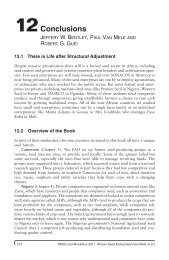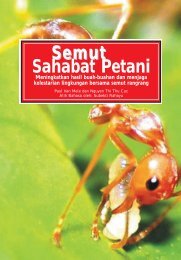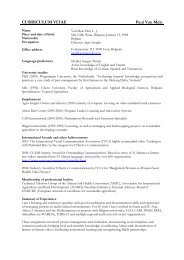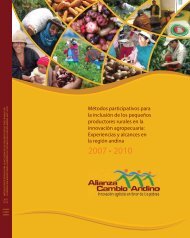Video-mediated farmer-to-farmer learning for sustainable agriculture
Video-mediated farmer-to-farmer learning for sustainable agriculture
Video-mediated farmer-to-farmer learning for sustainable agriculture
You also want an ePaper? Increase the reach of your titles
YUMPU automatically turns print PDFs into web optimized ePapers that Google loves.
4 Models of producing and disseminating <strong>farmer</strong> training videos<br />
4.1 <strong>Video</strong> production models<br />
Many respondents said that videos were most effective when <strong>farmer</strong>s presented and demonstrated<br />
good practices rather than experts. Taking this as a basis, various types of <strong>farmer</strong>-<strong>to</strong>-<strong>farmer</strong> training<br />
videos can be identified. Although all build in technical content checks, different styles and<br />
different types of engagement of <strong>farmer</strong>s, technical staff and communication professionals have<br />
led <strong>to</strong> quite distinct video <strong>for</strong>mats. We have limited ourselves <strong>to</strong> three distinct, well-documented<br />
types of <strong>farmer</strong>-<strong>to</strong>-<strong>farmer</strong> video and added a fourth type of video found on YouTube (Table 7).<br />
4.1.1 Agro-Insight<br />
<strong>Video</strong>s made according <strong>to</strong> the Agro-Insight style use a well-researched script with a voice over<br />
narra<strong>to</strong>r and a selection of <strong>farmer</strong> interviews. <strong>Video</strong>s are preferably made with graduates from<br />
<strong>farmer</strong> field schools (FFS). Underlying principles of technologies are explained and illustrated by<br />
local examples, using good quality close ups, simple graphics or analogy whenever needed.<br />
Collective action is shown as much as possible (http://agroinsight.com/resources.php).<br />
4.1.2 STCP cocoa<br />
The cocoa IPM videos made under the Sustainable Tree Crops Program (STCP) have more a dramatype<br />
of <strong>for</strong>mat combined with technical sections shown by FFS <strong>farmer</strong>s who were trained <strong>to</strong> make a<br />
video based on a s<strong>to</strong>ryboard (http://www.treecrops.org/links/trainingmaterial.asp).<br />
4.1.3 Digital Green<br />
The Digital Green videos use a dialogue <strong>for</strong>mat whereby an extension agent visits a progressive<br />
<strong>farmer</strong>, adhering <strong>to</strong> a s<strong>to</strong>ryboard. As distribution of the videos mainly takes place at the district<br />
level, many similar videos can be produced in slightly different contexts<br />
(http://www.digitalgreen.org/analytics/video_module/?geog=country&id=1).<br />
4.1.4 Kenyan <strong>farmer</strong><br />
The fourth type of video was produced in 2005 by the Earthwatch Institute. It shows a trained<br />
Kenyan <strong>farmer</strong> who explains and shows principles of soil fertility, land and water conservation<br />
(http://www.youtube.com/watch?v=mMapNsmGuAo).<br />
Organizations working with s<strong>to</strong>ryboards do not have scripts of the videos that are produced.<br />
Although it may look faster and less complicated at first <strong>to</strong> develop a video in ‘a simple<br />
participa<strong>to</strong>ry’ way, in reality there is only a slight difference in time (at first) with scripted video.<br />
However, when one wants <strong>to</strong> subsequently share the videos with <strong>farmer</strong>s speaking other<br />
languages, the unscripted, s<strong>to</strong>ryboard approach becomes a huge challenge as one has <strong>to</strong> sit down<br />
and transcribe all word by word, then translate it in<strong>to</strong> English be<strong>for</strong>e having it translated by<br />
someone else in the desired local language. At this stage unscripted video will require more time<br />
and investment than scripted ones.<br />
<strong>Video</strong> <strong>for</strong> <strong>farmer</strong>s Agro-Insight, Oc<strong>to</strong>ber 2011 page 24







